-
Posts
2,792 -
Joined
-
Last visited
Content Type
Profiles
Forums
Gallery
Events
Articles
Posts posted by bill
-
-
I need to bring this set up to date, but in the mean time you can read about some of the collection in the new issue of the ANA Journal (Vol 2, No. 1, Spring 2007), Midwinter Bird's-Eye View: So-called dollars document the development of the California Midwinter International Exposition.
-
Comitia Americana and Related Medals: Under Appreciated Monuments to Our Heritage
by John W. Adams and Anne E. Bentley
Published by George Frederick Kolbe, 1997
Beautiful book on a wonderful series. Its worth it for so many reason. but the photograph of Washington's original set of Comitia Americana medals in the original box commissioned by Thomas Jefferson is fairly special in and of itself.
-
And Bravo to this thread. Great reading.
-
Any thoughts on the J and S on the sails or is it something obvious that I have overlooked?
-
It is always a pleasure to visit your sites. Thank you.
-
I imagine you have a room in your home upholstered in black velvet. At night you lay out your copper coins and turn on tiny spotlights aimed at just the right places. Then you sit back and enjoy the glow from these beautiful coins!
You have an eye for circulated coppers. Amazing pieces.
-
I like that one, cleaned or not.
-
I don't know if the 1 Heller is as attractive in hand, but your lighting shows it off as a beautiful coin. Very nice.
-
1894 Base Metal, Paint
Electric Tower
21.2 mm, VF
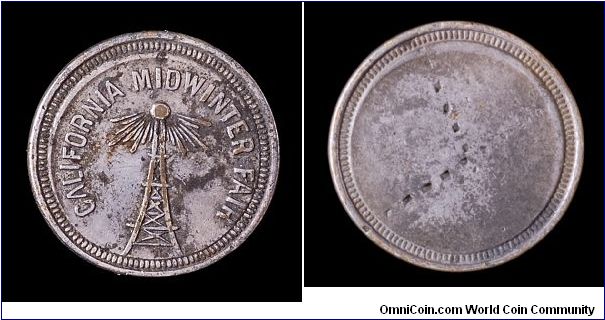
I don't really know what to say about this small piece. I bought it on Ebay, an item from a large collection of exposition memorabilia. It is definitely the Electric Tower on the obverse and the term, Midwinter Fair was used only in June, 1893 although it would be a quick and dirty way to refer to the exposition.
The medal is dirty, it reminds me of a penny that laid in a tool drawer in the service station for years. The accumulation of dirt, grease, general grime, and things rubbing against it creates an ugly, corroded mess. This piece, however, appears to have had the highlights painted red, or maybe it rubbed across something red that left a paint-like residue on the high spots. The reverse appears to have been run through a counter or other toothed wheel device that left two intersecting tracks. Maybe it was a button or glued to something else. I willing to entertain ideas at this point.
-
1894 Gilt Brass
Columbus Landing
Eglit 463
28.4 mm, F
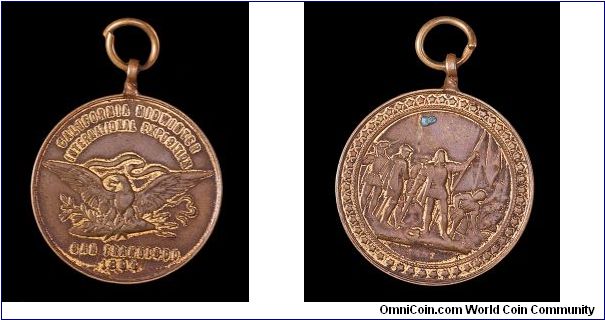
Well worn, but the best I've managed to win at auction so far.
Obverse: Spread eagle with E PLURIBUS UNUM banner in beak. Above CALIFORNIA MIDWINTER / INTERNATIONAL EXPOSITION, below SAN FRANCISCO / 1894.
Reverse: Landing of Columbus, 1892 below.
I've seen this piece listed as a mule of a Columbian Exposition and San Francisco Exposition medals. The piece is listed in Eglit and he notes this same design was used for a Columbian medal. In this instance, the legend was changed to reflect the San Francisco Exposition. I suspect pieces such as this were commissioned or produced in Chicago while the California exposition was being promoted in the summer of 1893.
-
1894 Brass
State Seal and Exposition Motto
27.7 mm, EF
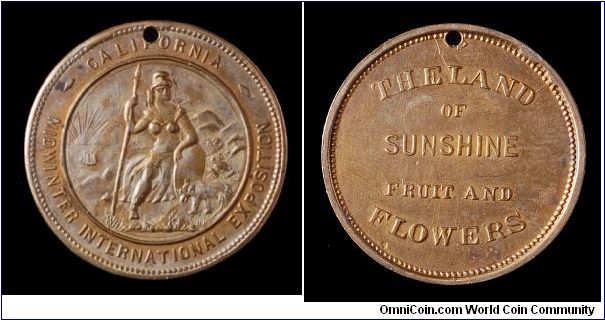
Obverse: Modified state seal, CALIFORNIA / MIDWINTER INTERNATIONAL EXPOSITION.
Reverse: THE LAND / OF / SUNSHINE / FRUIT AND / FLOWERS.
The scruffy looking bear leaves something to be desired and Minerva is facing forward as opposed to being shown in a side view as on the state seal. Minerva looks much like the image on the preceding badge. Perhaps they are from the same company or the same die engraver. This piece seems to be a cheap version of the so-called official medal posted above.
I have two of these, so I can definitely say the holes were added after the piece was struck. The second piece shows the same two die breaks visible on the reverse, plus a third dire break. It was obviously a later strike and it appears that the die may have been approaching the end of its useful life.
-
1894 Brass and Cloth
Souvenir Badge
35 mm wide, EF
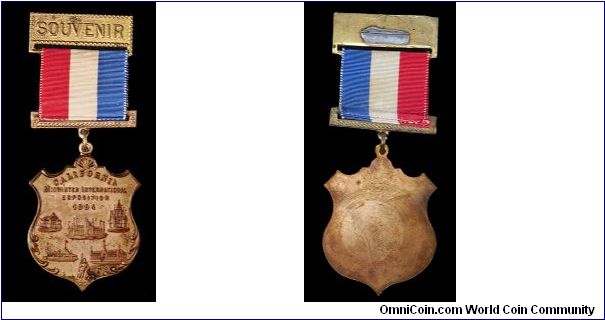
Exonumia covers a wide range of items including badges. The badge pictured here features the five primary buildings located around the central court of honor. Minerva from the state seal (at the bottom of the badge) faces forward. I'll post another souvenir with the same Minerva pose. Perhaps the two were made by the same company although neither is marked. The pin is missing from this badge.
Badges are an interesting clue to the reason so many early medals are holed. They were attached to things or to ribbons for wearing. I've been scanning early photographs to try to spot people wearing badges. No luck yet, but one day....
-
1894 Aluminum
Lauer Exposition View So-Called Dollar
Hibler & Kappen 262
35.6 mm EF
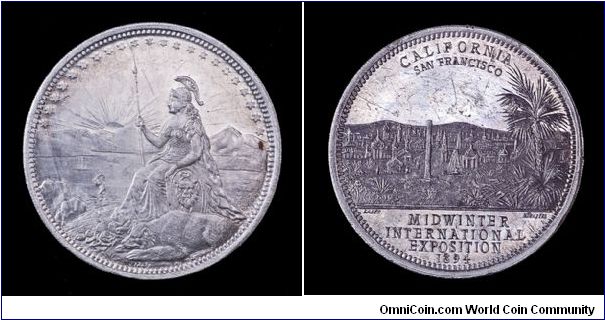
Obverse: State seal, signed LAUER at bottom.
Reverse: Idealized view of the exposition grounds, CALIFORNIA / SAN FRANCISCO above, MIDWINTER / INTERNATIONAL / EXPOSITION / 1894 in exergue. LAUER NÜRNBERG in small letters below central image.
Lauer of Nürnberg, Germany won a gold medal at the exposition for their medal manufacturing exhibit. Six differerent medals were issued.
-
1894 Bronze
Labor and Liberty Badge
32 mm, EF-AU
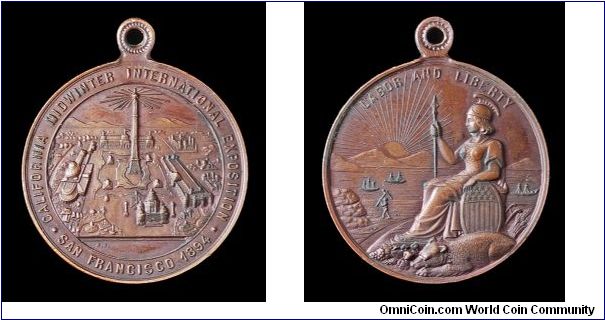
Obverse: Bird’s eye view, CALIFORNIA MIDWINTER INTERNATIONAL EXPOSITION / SAN FRANCISCO 1894. Initials S.J. in exergue.
Reverse: State seal with LABOR AND LIBERTY above.
I like the bird's eye view images and have submitted a proposed article on the topic to the ANA Journal. Its being reviewed now. I'll let everyone know if it is accepted. I can't say much more about this piece except that San Francisco has long been a labor city. Construction work on the fair was restricted to the unionized trades. I suspect this piece was issued for a Labor sponsored day at the exposition.
-
A few new acquisitions.
For my French collctions:
Historie du Roy Louis le Grand par les Medailles by Claude-François Menestrier (Chez I.B. Nolin, Paris, 1693)
For my numismatic history (and David Bowers) collection:
Virgil Brand: The Man and His Era, Profile of a Numismatist (Bowers and Merena, 1983, Hardbound, signed)
Abe Kosoff: Dean of Numismatics (Bowers and Merena, 1985, Hardbound, signed and numbered)
An Inside View of the Coin Hobby in the 1930s: The Walter P. Nichols File (Bowers and Merena, 1984, Softbound)
The Norweb Collection: An American Legacy (by Michael Hodder and Bowers, Bowers and Merena, 1987, Hardbound, signed, numbered).
and finally, for my general library:
The Early Paper Money of America by Eric P. Newman (3rd Edition, Krause Publications, 1990)
-
I haven't exactly kept up to date, but I did acquire Michael Mitchiner's Jeton's, Medalets & Tokens, Volume 2 The Low Countries and France.
Francis Paul Prucha's Indian Peace Medals in American History
but the most interesting came by accident today as I scanned a used bookstore that was new to me.
Matthew Boulton by H.W. Dickinson, Cambridge, 1937. It is a science biography, history volume with a chapter on Coinage and the Soho Mint. An appendix includes a Memoir of Boulton by James Watt written in 1809. Some foxing, but it looks like a decent biography.
-
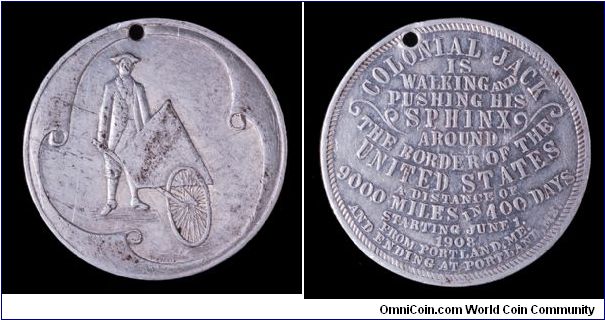
Colonial Jack and Sailor Jean are one and the same. It is the same trolleyette, a collapsable frame and a bicycle wheel. Sailor Jean's trolleyette carried a barrel with his stuff including tokens and doo dads to sell, clothes, etc. He sometimes slept out, but often stayed in hotels. The "sail" atop the barrel is an army tent.
Colonial Jack replaces the Barrel with a pyramid (the sphinx). Same idea. Both became billboards for businesses attaching cards for a fee.
His book: The Walk of Colonial Jack by John A. Krohn (1910). To quote Krohn:
Why did I push a wheelbarrow around the border of the United States?
To make money by selling my story.
But "the love of money is root of all evil."
Yes; still, most of us need the "root."
-
Sailor Jean walked his way into fame
 and fortune
and fortune 

 .
.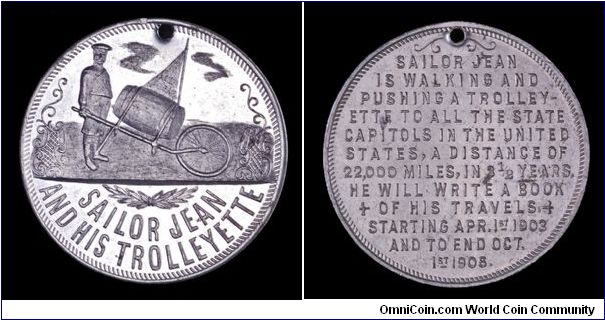
38mm Aluminum
One of a number of people around the world who walked long distances and sold souvenirs to support their quests. I don't know if Sailor Jean ever wrote his book, but he wrote one later as Colonial Jack. I'll post that token later.
I've managed to piece together a file on this character and I tracked down a copy of his book. I'm working on an article about his exploits.
-
Nice piece. Elegant design.
-
1893 Aluminum
Mexican Souvenir Columbian Exposition
about 2 inches square, Unc
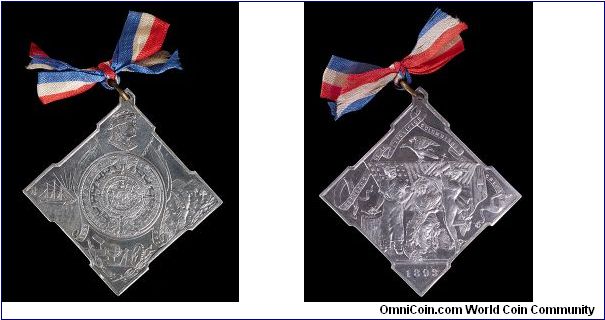
I know nothing about this piece except I have a matching one from the California Midwinter International Exposition, 1894 (here).
The obverse features a bust of Columbus at the top, the Aztec calendar in the middle, and navigational instruments at the bottom. To the left is a ship, a steam train to the right. The dates 1492 and 1892.
The reverse features an allegorical scene with a male adorned for blacksmith work, a female with grains, and Hermes (or Mercury) the messenger of the gods known for his helpfulness to mankind. Behind them is the American flag and an eagle. The banner above reads, RECUERDO DE LA EXPOSICION DE CHICAGO. 1893 below.
-
1894 Aluminum
Mexican Souvenir California Exposition
about 2 inches square, Unc
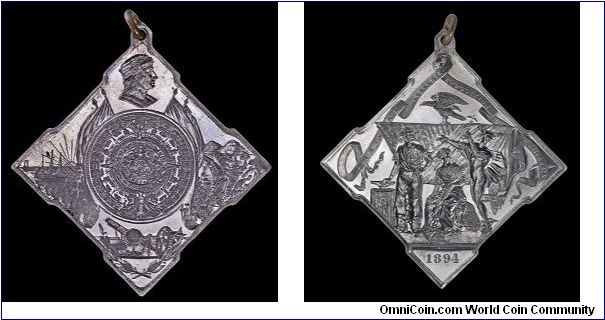
I know nothing about this piece except I have a matching one from the Columbian Exposition, 1893 (here).
The obverse features a bust of Columbus at the top, the Aztec calendar in the middle, and navigational instruments at the bottom. To the left is a ship, a steam train to the right. The dates 1492 and 1892.
The reverse features an allegorical scene with a male adorned for blacksmith work, a female with grains, and Hermes (or Mercury) the messenger of the gods known for his helpfulness to mankind. Behind them is the American flag and an eagle. The banner above reads, MEXICAN SOUVENIR EXPOSITION CALIFORNIA. 1894 below.
-
1894 Aluminum
State Seal - Administration Building
51 mm, Unc
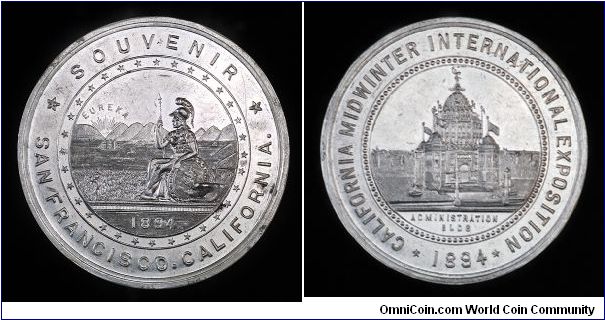
A large souvenir medal from the exposition. At 51 mm, it is too large to count as a so-called dollar. Since there are no catalogs for the Midwinter pieces, this naturally counts as "unlisted" although I've encountered an auction record for one other piece so far. If my collection progresses at the current pace, I write something one of these days.
-
1894 Brass
Official Medal Type I So-Called Dollar
Hibler & Kappen 245
34 mm VF
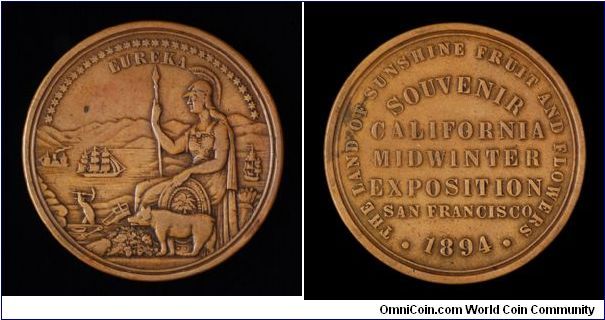
1894 Brass
Official Medal Type II So-Called Dollar
Hibler & Kappen 245A
34 mm AU
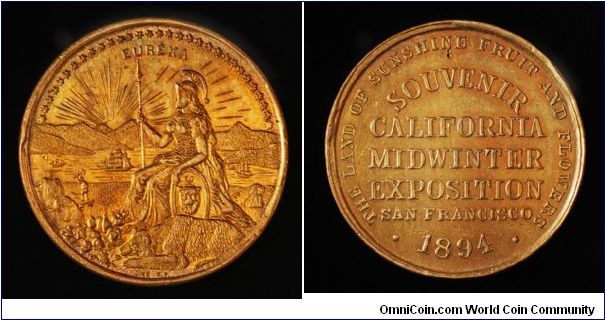
Okay, they are not aluminium. I've focused a part of my collection on this exposition and am looking for one rare so-called dollar struck in white medal. Nearly everything else is aluminum (there are sone other non so-called dollar exceptions).
The obverse is the California state seal. Type I is a fairly accurate rendering with the exception of fruit and flowers at the feet of Minerva (read the reverse inscription). Type II adds arising sun at the crest of the Sierra Nevadas (again, read the reverse inscription). The maker's mark, MOISE S.F. appears at the base of the image.
The reverse of both reads, THE LAND OF SUNSHINE FRUIT AND FLOWERS / SOUVENIR / CALIFORNIA / MIDWINTER / EXPOSITION / SAN FRANCISCO / 1894. The reverses are not identical. The words are the same, but different letter punches were used and the sizes and placements are slightly different. The lettering placement, spacing, etc. feels more "professional" on Type I.
I believe these medals were commissioned by the exposition planners and that Type I was ordered and struck by the exposition's publicity office in Chicago. The San Francisco office opened second and I believe they ordered matching medals in San Francisco for use in the west. Moise added the sun on the obverse as well as their hallmark.
-
1894 Aluminum
Sun-Set City - Mechanics Art Building So-Called Dollar
Hibler & Kappen 253
38.5 mm EF
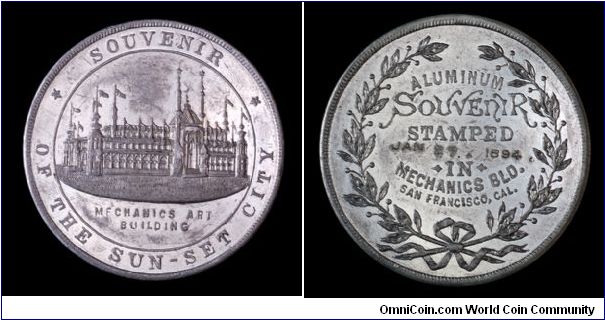
Obverse: Mechanics Art Building. Outer ring reads, SOUVENIR / OF THE SUN-SET CITY.
Reverse: Wreath, ALUMINUM / SOUVENIR / STAMPED / IN / MECHANICS BLD. / SAN FRANCISCO, CAL.
This particular medal is interesting since it has been counterstamped JAN 27 1894 in the overly large space between the words STAMPED and IN. The space appears suited to adding a date and Jan 27, 1894 was opening day for the exposition. I guess you could consider this a first day of issue piece.
The exposition grounds in Chicago were known as the White City for the fair's classical architecture. In San Francisco, the exposition grounds were located next to a property development known as the Sunset City. The color scheme selected for the exposition architecture, however, led to the local nickname, the Opal City.
The Mechanics Art Building and Electric Tower designs from the two "Stamped In" medals pictured here and above were adapted from water color promotional artist's renderings painted by Charles Graham.


Numismatic books
in Numismatic Book Forum
Posted
Welcome, I spotted your name and avatar when you joined. I love books as well as coins (and photography). I wish I could afford to attempt to collect the series in original die states (a proof, original Libertas at Kagin's bourse table--I will never forget holding that beauty even though it was encapsulated), but it is still an interesting and historical series in the later French and US Mint strikings. Not real expensive and still something one can appreciate. I would love to see your efforts posted here when you are ready.